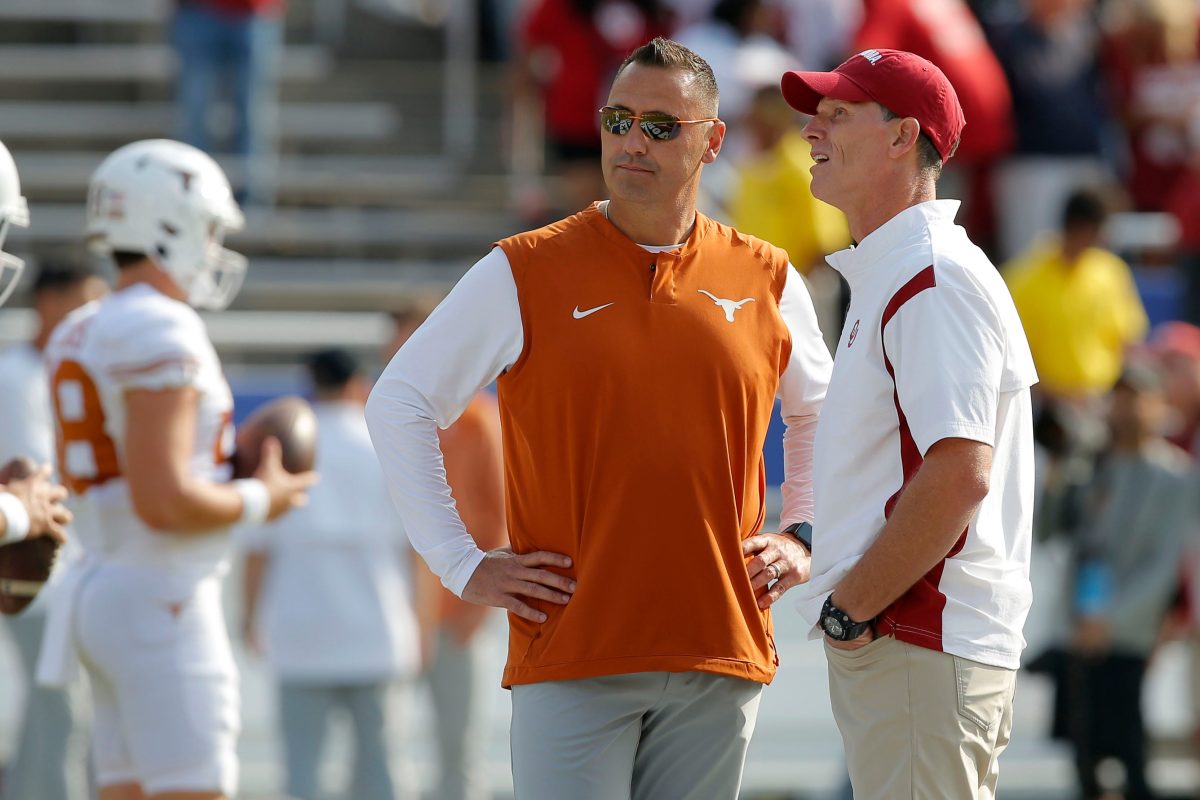What’s going on in the Big 12 and beyond? I expand and explain every Sunday in Postscripts at Heartland College Sports, your home for independent Big 12 coverage.
This week, the moment has arrived. The Texas Longhorns and Oklahoma Sooners are exiting the Big 12 for good. So, let’s dig in.
The Long Goodbye
Earlier this week I was asked to write about the departures of Oklahoma and Texas from the Big 12. It’s a story that has been nearly three years in the making. But on Monday it becomes final. The two programs that helped define the league will officially join the SEC.
How do you summarize the impact of two teams, two programs, like Oklahoma and Texas on the Big 12 in one story? Well, it’s complicated. And to understand why we’re saying goodbye we have to understand where this all started — and it wasn’t three years ago.
If you were to draw a line from here to where all of his started you have to go back to 1990 when Arkansas announced it was leaving the Southwest Conference for the SEC (the conference also invited South Carolina). At the time college athletics was incredibly stable. Contrast that to where we are now and that will probably be impossible for some of you to comprehend.
But when Arkansas decided to accept the SEC’s invitation it had a ripple effect that has worked its way through college athletics for more than three decades, but in the immediate term it led to the destruction of the SWC.
Arkansas’s move was about money. NCAA v. Board of Regents of the University of Oklahoma gave conferences the chance to negotiate their own TV deals. The SEC added Arkansas and USC and left what was called the College Football Association to negotiate its own deal. And the money race was on.
Did you know at one point the SWC considered inviting Tulane and Miami (FL) to survive? Did you know that at one point the Pac-10 courted Texas and Oklahoma for expansion? Did you know at one point the same two schools were talking to the SEC? None of that worked out. So in 1994 Texas, along with Baylor, Texas A&M and Texas Tech headed for the Big 8 and the Big 12 was formed. The rest were left behind.
Longhorns, Sooners Struggle
Back then, neither Oklahoma nor Texas football was in a great place. OU hired Howard Schnellenberger in 1995 and he lasted 11 games. Then came John Blake, who went 12-22 over three seasons, the program’s first three in the Big 12. Texas was working through the John Mackovic era.
Meanwhile, Nebraska was on top of the world. Under Tom Osborne the Cornhuskers won the 1997 national title, the conclusion of a four-year run that saw Nebraska go 49-2 and won three national titles. Then Osborne retired.
Texas hired Mack Brown after the 1997 season. Oklahoma hired Bob Stoops after the 1998 season. Things changed fast. OU won a national title in 2000. Texas won one in 2005. Nebraska remained successful under Frank Solich, but when Nebraska showed him the door, the program slowly became less relevant, which was accelerated by the move to the Big Ten.
I was taken aback by a post on our Heartland College Sports message boards (sign up and join the conversation here for free) the other day touting the idea of unequal revenue sharing in the new Big 12. That’s what nearly destroyed the league in the first place.
Fifteen years ago the league distributed revenue unequally. Four schools, according to former commissioner Dan Beebe, stood in the way of equal splits — Nebraska, Oklahoma, Texas and Texas A&M. Beebe would say later that some schools wanted to develop their own ways to deliver their sports programming.
Ever heard of the Longhorn Network? Or Sooner Vision? Yep. That’s what they did. And, that, in part led to Nebraska heading to the Big Ten, Colorado heading to the Pac-12 and A&M along with Missouri heading to the SEC.
If Texas and Oklahoma weren’t already charting the direction of the league, that solidified it. But, even then, they were trying to get out.
Both had reported flirtations with the SEC and the Pac-12 at the time. When both finally fell through, only then did they commit to the Big 12 again. But, even then, Texas didn’t want the grant of rights or the equal revenue sharing. It only finally agreed to equal distribution of its Tier I and Tier II rights as long as it could keep its Tier III rights (LHN).
After all that chaos, the grant of rights was necessary. But Texas, and less notably Oklahoma, still couldn’t completely play ball. The league’s membership was equal in name only. Some athletic directors and presidents were able to keep their bitterness private. Others were not. Beebe lost his job amid all the drama.
The romantic view at the time, was that the league was now stable and expanding with TCU and West Virginia. The reality was that Texas and Oklahoma had exhausted all of their exit options and no other conference was ready to take them in — yet.
2012 and Beyond
After 2012, when everything settled, Texas and Oklahoma continued to set the direction of the league. Remember expansion back in 2016 under then-commissioner Bob Bowlsby? Yeah, Texas and Oklahoma were among the schools that voted against that. Discussions about a Big 12 Network never got off the ground because those two schools were not interested in sharing their third-tier rights, a necessity for that kind of network.
That’s why the league now has Big 12 Now on ESPN+ and not its own network.
My biggest issue with all of this has been that I’ve always thought of Texas and Oklahoma as leaders. Joining the SEC is a follower move. Turns out the two were trying to follow the money for a long time.
So it shouldn’t have been that surprising when the pair announced they were bolting for the SEC in 2021, even though it stunned most people. Bowlsby was visibly irked, as he worked with SEC commissioner Greg Sankey for six months on College Football Playoff expansion before the news broke. Not a peep. Perhaps Sankey should run the CIA?
None of this went down the right way, but this is where it’s been going for years, as it turns out. A Houston Chronicle article is the only thing that kept the secrecy from going on longer.
Betrayal? Sure. And like all good relationships gone bad, it was a slow walk to get to the divorce.
A Non-Oklahoma and Texas Big 12
“The Hateful Eight,” the cool nickname for the remaining teams in the Big 12, had every right to be unhappy after all of that. And they were. But they processed quickly. And the only favor they got from Texas and Oklahoma was three years’ notice. And given the notice the Pac-12 got from USC and UCLA (two years) and the deal that is handcuffing the ACC right now, it was a big favor.
The remaining schools had time to figure things out, though they moved fast. Remember the Big 12 expansion Texas and Oklahoma stood against? The remaining schools did that less than three months after the announcement — and against the objections of those two schools, who would have preferred for the league to wait until they were gone.
“The Hateful Eight” was done with that. They didn’t have to cater to them anymore, not when the future doesn’t involve them.
Since then, business has been separated at Big 12 meetings. When there was current business, Texas and Oklahoma were in the room. When it was time for new business, they left. Texas and Oklahoma were polite enough at that point not to raise a fuss about it. They respected the grant of rights, in part because they knew breaking it would cost more than the $100 million they eventually surrendered to exit one year early. Texas and Oklahoma are rich, but you don’t stay rich by spending it all.
Without Texas and Oklahoma their agendas went away and Bowlsby, followed by his replacement, Brett Yormark, were able to guide the Big 12 into stability and expansion, perhaps more expansion than it expected. But as the league moves to 16 teams next month, that is due, in part, to the collective remainder of the conference learning the lessons from the league’s uneven past and keeping it even.
To the Texas and Oklahoma fans who, at times, hit social media and take their shots at the Big 12 as a “second-rate” conference and say you can’t wait to get out, well your day is here. But remember that your two schools’ desire to do your own thing contributed to all of this. Moving to the SEC is a business decision and more money will be made. But, for the first time your media rights and your importance will be considered the same as Vanderbilt’s and Kentucky’s. How does that strike you?
The Big 12 will be fine without Texas and Oklahoma, contrary to some. It already is. The league will be the most competitive conference in the country this coming athletic year, especially in football and men’s basketball. Football may only get one team in the College Football Playoff, but it’s going to be a blast figuring out who it will be.
So, today, as the Sooners and the Longhorns leave, feel free to lament it, celebrate it, throw up a Horns Down at it. Your emotions are yours. As a Texan, the whole thing feels weird and it’s going to take some getting used to. But it’s been 35 years in the making and this, ultimately, is what both of them wanted — to follow the money right out of tradition.
Does this mean they won? I suppose that all depends on your definition.
You can find Matthew Postins on Twitter @PostinsPostcard.

























